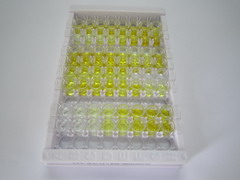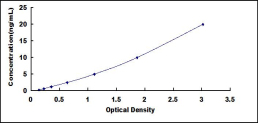Packages (Simulation)

Reagent Preparation

Image (I)
Image (II)
Certificate


ELISA Kit for Occludin (OCLN)
Tight Junction Protein Occludin TM4 Minus
- Product No.SEC228Mu
- Organism SpeciesMus musculus (Mouse) Same name, Different species.
- Sample TypeTissue homogenates, cell lysates and other biological fluids
- Test MethodDouble-antibody Sandwich
- Assay Length3h
- Detection Range0.312-20ng/mL
- SensitivityThe minimum detectable dose of this kit is typically less than 0.132ng/mL.
- DownloadInstruction Manual
- UOM 48T96T 96T*5 96T*10 96T*100
- FOB
US$ 504
US$ 720
US$ 3240
US$ 6120
US$ 50400
For more details, please contact local distributors!
Specificity
This assay has high sensitivity and excellent specificity for detection of Occludin (OCLN).
No significant cross-reactivity or interference between Occludin (OCLN) and analogues was observed.
Precision
Intra-assay Precision (Precision within an assay): 3 samples with low, middle and high level Occludin (OCLN) were tested 20 times on one plate, respectively.
Inter-assay Precision (Precision between assays): 3 samples with low, middle and high level Occludin (OCLN) were tested on 3 different plates, 8 replicates in each plate.
CV(%) = SD/meanX100
Intra-Assay: CV<10%
Inter-Assay: CV<12%
Stability
The stability of kit is determined by the loss rate of activity. The loss rate of this kit is less than 5% within the expiration date under appropriate storage condition.
To minimize extra influence on the performance, operation procedures and lab conditions, especially room temperature, air humidity, incubator temperature should be strictly controlled. It is also strongly suggested that the whole assay is performed by the same operator from the beginning to the end.
Reagents and materials provided
| Reagents | Quantity | Reagents | Quantity |
| Pre-coated, ready to use 96-well strip plate | 1 | Plate sealer for 96 wells | 4 |
| Standard | 2 | Standard Diluent | 1×20mL |
| Detection Reagent A | 1×120µL | Assay Diluent A | 1×12mL |
| Detection Reagent B | 1×120µL | Assay Diluent B | 1×12mL |
| TMB Substrate | 1×9mL | Stop Solution | 1×6mL |
| Wash Buffer (30 × concentrate) | 1×20mL | Instruction manual | 1 |
Assay procedure summary
1. Prepare all reagents, samples and standards;
2. Add 100µL standard or sample to each well. Incubate 1 hours at 37°C;
3. Aspirate and add 100µL prepared Detection Reagent A. Incubate 1 hour at 37°C;
4. Aspirate and wash 3 times;
5. Add 100µL prepared Detection Reagent B. Incubate 30 minutes at 37°C;
6. Aspirate and wash 5 times;
7. Add 90µL Substrate Solution. Incubate 10-20 minutes at 37°C;
8. Add 50µL Stop Solution. Read at 450nm immediately.
GIVEAWAYS
INCREMENT SERVICES
-
 Single-component Reagents of Assay Kit
Single-component Reagents of Assay Kit
-
 Lysis Buffer Specific for ELISA / CLIA
Lysis Buffer Specific for ELISA / CLIA
-
 Quality Control of Kit
Quality Control of Kit
-
 ELISA Kit Customized Service
ELISA Kit Customized Service
-
 Disease Model Customized Service
Disease Model Customized Service
-
 Serums Customized Service
Serums Customized Service
-
 TGFB1 Activation Reagent
TGFB1 Activation Reagent
-
 Real Time PCR Experimental Service
Real Time PCR Experimental Service
-
 Streptavidin
Streptavidin
-
 Fast blue Protein Stain solution
Fast blue Protein Stain solution -
 Single-component Reagents of FLIA Kit
Single-component Reagents of FLIA Kit
-
 Streptavidin-Agarose Beads
Streptavidin-Agarose Beads
| Magazine | Citations |
| Brain Research | HIV-1 Tat protein increases the permeability of brain endothelial cells by both inhibiting occludin expression and cleaving occludin via matrix metalloproteinase-9 ScienceDirect: S0006899311021408 |
| Plos one | Disruption of the Circadian Clock in Mice Increases Intestinal Permeability and Promotes Alcohol-Induced Hepatic Pathology and Inflammation PubMed: PMC3688973 |
| Journal of Neurotrauma | A new panel of blood biomarkers for the diagnosis of mild traumatic brain injury/concussion in adults PubMed: 25794137 |
| United States Patent Application | Methods for Diagnosis and Treatment of Concussion or Brain Injury 2016:0103140 |
| Sci Rep. | Blood Occludin Level as a Potential Biomarker for Early Blood Brain Barrier Damage Following Ischemic Stroke articles:srep40331 |
| Frontiers in Pharmacology | Traditional Herbal Medicine-Derived Sulforaphene LFS-01 Reverses Colitis in Mice by Selectively Altering the Gut Microbiota and Promoting Intestinal … Pubmed:29375374 |
| Thorax | Fas activation alters tight junction proteins in acute lung injury Pubmed: 30385692 |
| Antioxidants (Basel). | The Effect of Dietary Quercetin on the Glutathione Redox System and Small Intestinal Functionality of Weaned Piglets Pubmed: 31426309 |
| DISEASE MARKERS | Peripheral blood occludin level as a biomarker for preoperative cerebral edema in patients with brain tumors Pubmed: 32884584 |
| Burns Open | Intestinal Permeability in Participants With Thermal Injury: A Case Series From a Prospective, Longitudinal Study (HESTIA) |
| PLoS One | A comparison of the effects of monotherapy with rosuvastatin, atorvastatin or ezetimibe versus combination treatment with rosuvastatin-ezetimibe and … 34492054 |
| CNS Neuroscience & Therapeutics | Higher serum occludin after successful reperfusion Is associated with early neurological deterioration Pubmed:35338575 |
| Impact de l'incorporation d'acides gras à chaine moyenne, de suppléments de levures et d'avoine nue sur la santé intestinale ainsi que sur la consommation … |
| Catalog No. | Related products for research use of Mus musculus (Mouse) Organism species | Applications (RESEARCH USE ONLY!) |
| RPC228Mu01 | Recombinant Occludin (OCLN) | Positive Control; Immunogen; SDS-PAGE; WB. |
| RPC228Mu03 | Recombinant Occludin (OCLN) | Positive Control; Immunogen; SDS-PAGE; WB. |
| RPC228Mu02 | Recombinant Occludin (OCLN) | Positive Control; Immunogen; SDS-PAGE; WB. |
| RPC228Mu04 | Recombinant Occludin (OCLN) | Positive Control; Immunogen; SDS-PAGE; WB. |
| RPC228Mu05 | Recombinant Occludin (OCLN) | Positive Control; Immunogen; SDS-PAGE; WB. |
| PAC228Mu02 | Polyclonal Antibody to Occludin (OCLN) | WB; IHC; ICC; IP. |
| PAC228Mu01 | Polyclonal Antibody to Occludin (OCLN) | WB; IHC; ICC; IP. |
| LAC228Mu71 | Biotin-Linked Polyclonal Antibody to Occludin (OCLN) | WB; IHC; ICC. |
| SEC228Mu | ELISA Kit for Occludin (OCLN) | Enzyme-linked immunosorbent assay for Antigen Detection. |
| LMC228Mu | Multiplex Assay Kit for Occludin (OCLN) ,etc. by FLIA (Flow Luminescence Immunoassay) | FLIA Kit for Antigen Detection. |






